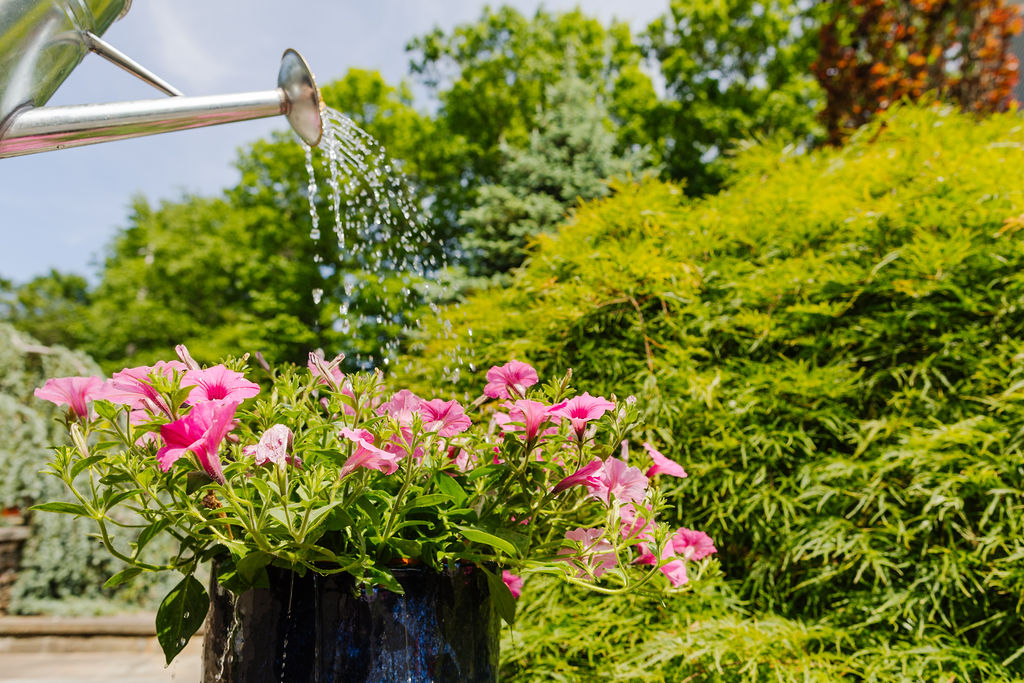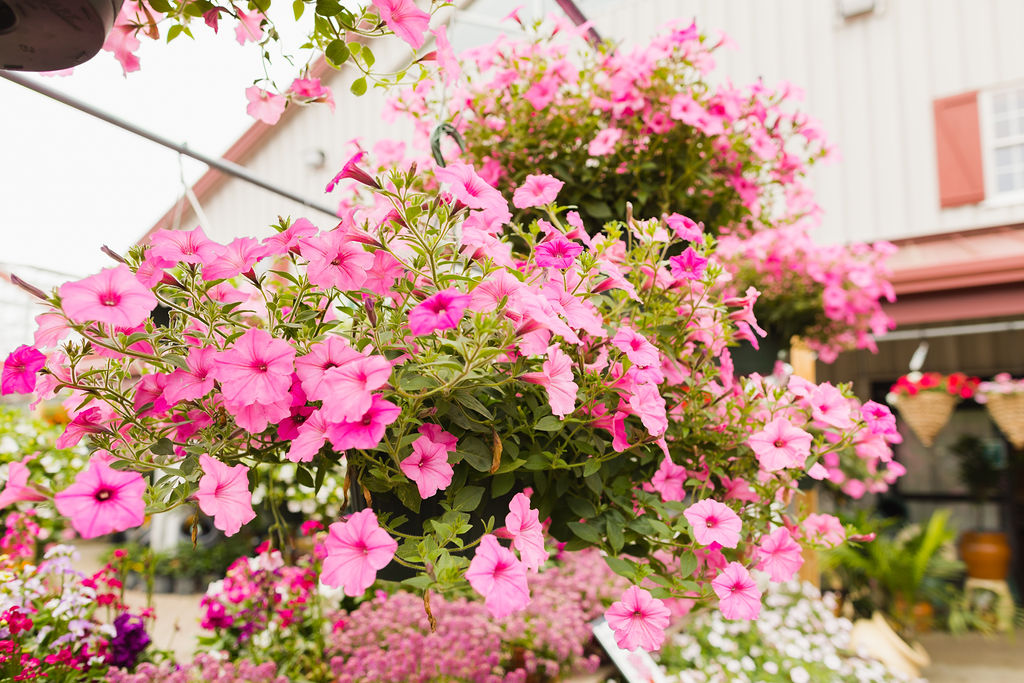Summer is all about being outdoors!
Questions about watering? The biggest thing is knowing when and how much to water your plants. We’ve compiled some tips to help you know when and how to water during those hot summer months.

SIGNS YOU NEED TO WATER:
Wilting: One of the very simple to spot and most obvious ways to tell your plant needs water is whether the flowers and leaves are wilted. Wilting can also be an indicator of heat stress.
Yellow Leaves: When your plant’s leaves start to yellow around the edges AND the soil is dry, you need to water. Yellowing in leaves can mean one of two things. One, your soil is too wet, and the roots are suffocating. Or, two, your soil is too dry, and the plant is starving for water. Be sure to check the soil when you see yellowing leaves before grabbing the watering can.
Stunted Growth: If there is a change in the rate of growth of your plant, it could be time to water. Another indicator of stunted growth is seeing fewer blooms than you’d expect on an otherwise healthy plant.
Weight: When you are watering potted plants or hanging baskets, be sure to test the weight before and after you water to note the difference. The next time your plant needs water you can check the weight to determine how much water you may need.
Helpful Hints:
- On a very hot summer day, be sure to run the hose water for a second before turning to water your plants. The hot water in your hose can also cause scalding or burn the plant. When you’re watering aim the hose or watering can directly at the base of the plant, focusing on the root system. Do your best to avoid getting water on the leaves if you can.
- Saturate the entire root system when you’re watering to make sure you’re giving your plants the most nourishing drink. You can use the weight test or check the soil to be sure you’ve watered enough.

If you water your hanging baskets in the morning, you may want to check them again in the afternoons of July and August. In many cases, it is not uncommon to water your hanging baskets more than once per day, especially if it is very hot outside and your plant is in direct sunlight. Each time you water a hanging basket you must be sure you’re giving them enough. You need to make sure that you’re saturating the entire root system until water drains out the bottom of the pot.
There are ways to tell if your plants are dry as we’ve mentioned before, but what about your soil? The weight test is always good for hanging baskets or potted plants. Once you see the watering draining from the pot in a steady stream, lift the basket and test the weight. You can also use a barbeque skewer or stick and put it down in the soil at least 3 or 4 inches deep. With a dry basket, your stick will come out clean. If your plant is fully saturated, it will come out dirty.
Here is a printable guide to help you. Watering Guide_2022
Types of roses

Picking a rose plant is a matter of personal preference. Do you want fragrance, a climber, lots of blooms, a certain bloom size, or a compact plant? Here are the types of roses and their basic differences so you choose the type that fits your gardening plan:
- Climbers: Vigorous, sprawling rose plants that need the support of an arbor, fence, or trellis to stay upright.
- Floribundas: Free-blooming shrubs that produce tons of flowers, usually borne in large clusters. One of the best types of roses for landscaping.
- Grandifloras: Vigorous bushes producing large, beautifully formed flowers that are more likely to be borne in clusters than one to a stem.
- Hybrid teas: The most popular type of rosebush, with beautiful long-stemmed flowers that are ideal for cutting.
- Miniatures: Small in leaf and stature but big in the amount of bloom. Grow only 4 to 36 inches high but make great landscape plants, especially as edgings and in containers.
Stop in and ask any of our knowledgeable, friendly staff to assist in choosing the perfect roses for your garden.
Ways to extend your enjoyment
Roses carry an air of elegance and romance. You might catch a whiff of an incredible fragrance or just a touch of luxury. Try one of these many ideas to extend your enjoyment inside the house!
Drying Petals
Collect petals from unsprayed plants. Avoid wilted or browned petals. Air dry in single layers on paper towels or screens until completely dry. Store dried petals in paper bags or glass jars out of sunlight for 9 to 12 months. Freeze rose petal tea in ice trays, and use it within 3 to 6 months.
Potpourri:
You can make your own potpourri by blending dried rose petals with complementary scents like cinnamon sticks, dried ginger, or whole vanilla beans, and put the mixture anywhere you want to freshen up. Sock drawers, linen closets, and the bathroom are all ideal options, and you can let the scents soothe you to sleep by slipping a small sachet into your pillowcase.
Lotion Bars:
Melt together 1/4 cup of each: infused oil, beeswax, shea, or mango butter, and pour into small molds
Salve:
Melt 3.5 oz infused oil with 0.5 oz beeswax.
Infused oil:
1 part dried flowers covered with 2 to 3 times as much oil
– Use infused oil for lip balm, salves, lotion bars, creams, scrubs, soap
Vinegar:
Fill jar 1/2 to 3/4 with fresh petals, top with vinegar, infuse for several weeks
– Use vinegar for hair rinse, cleaning spray, bug bites, vinaigrette
Witch Hazel:
Make just like vinegar, but for external use only
Tea:
Fill a jar with fresh rose petals, cover with simmering water, and steep 5 to 10 minutes for drinking, or until cooled for skin care projects
Rose Bath Salts
These rose petal bath salts are quick and easy to make and smell wonderful! They make a great gift too!
You’ll need:
- 1 cup Epsom salt
- several drops of rose or geranium (rose) essential oil
- a handful of dried rose petals
- (optional) 1/4 cup sea salt.
Combine the Epsom salt with sea salt, if using. Rub the dried rose petals between your fingers to crush them into tiny pieces. Stir into the salt. Add several drops of rose or geranium essential oil. Stir well and pour into a pretty jar.
To use: Pour into a cotton muslin bag or tie up in a clean sock. Drop the bag into comfortably warm water as it fills your tub.